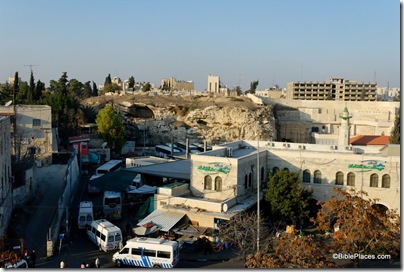General Charles Gordon was a well-known British leader when he came to live near Jerusalem in 1882, often visiting the home of Horatio and Anna Spafford, founders of the American Colony. From their quarters atop the northern wall of the Old City, Gordon had a view of a rocky escarpment in which he identified the features of a skull. He identified this location as the “Place of the Skull” (Aramaic: Golgotha; Latin: Calvary). Around the corner was an ancient tomb which he believed was the empty tomb of Christ. A decade later, the property was purchased by a concerned group of Christians in England and the Garden Tomb Association was formed.
In this photo, taken between 1898 and 1914, the view is similar to the one that Gordon had from the American Colony home. The caves that form the eye sockets of the skull are visible just left of center. The tomb is out of view behind the wall on the left side. On the top of the hill some tombs of the Muslim cemetery can be seen. The camels are walking east along what is today a busy four-lane street.
The photo below was taken in 2006 and the most prominent feature is the bus station. The two “eye sockets” are visible, but most of the rest of the landscape is covered. If you believe that Jesus was crucified in this area, you’ll do better using the black and white photo to visualize the event.
Concerning the tomb’s authenticity, Robert Alexander Stewart Macalister wrote in 1907:
It is a pity that so much is claimed for [this tomb]; the prejudice raised thereby is apt to blind one to the fact that it is a remarkably interesting sepulchre. . . . In conversation with tourists at the hotel in Jerusalem I constantly hear such a remark as this: ‘I came to Jerusalem fully convinced that the Church of the Holy Sepulchre was the true site; but I went to the Church and saw all the “mummery” that goes on there, and I saw the Muhammadan soldiers guarding the place to prevent the Christians fighting. Then I went to that peaceful garden: and then I knew that the church was wrong, and that Gordon had found the real site.’ This is the most convincing argument that can be advanced in favor of the tomb, and it is obviously quite unanswerable (Palestine Exploration Quarterly, 1907, p. 232).
The top photo is one 15 photographs in a presentation of the Garden Tomb in the newly released Jerusalem CD, volume 2 of The American Colony and Eric Matson Collection. The presentation includes a carefully researched history of the area. Photo: Library of Congress, LC-matpc-06666.


8 thoughts on “Gordon’s Calvary, Then and Now”
very nice work todd. really very nice. personally, if i had to choose between this site and the traditional one, i'd pick gordon's any day. it's fantastically beautiful inside that garden. thanks for taking me back to my last visit there.
I had a Roman history professor in college who used to say that all a British historian had to say to back up some historical claim was "I know it's true, because I feel it in the marrow of my bones", and his assertion would be accepted on the spot.
There are a number of things that work against Gordon's Calvary. One is that rock cliff was the site of a rock quarry in the recent centuries before Gordon discovered it. Another is the tomb has been dated to 7th or 8th century B.C., and the gospels say it was a new tomb.
http://www.gci.org/Jesus/golgotha
Also, no evidence of any crucifixions have been found on top of that hill.
The Romans used Crucifixion as exemplary punishments so possibly the side of the Road to Damascus would be where the three crucifixions took place beneath the place of the skull.
Another source has no mention of Jesus' crucifixion being on the top of a hill – the Bible. Yes, the imagery of the crucifixion taking place on the top of a hill comes from the beloved hymn, The Old Rugged Cross. According to the guide at the Garden Tomb, maximum exposure of crucified criminals would be along the roadside running in front of the site.
I had a chance to wisit the place with my family and had a swedish guide.This man told about some clues that could point in the direction that it actually could be the place:
1. Its close to calvary, as it is written in the gospells
2. There is garden there, as it is written in the gospells
3. There is a big water reservoar down under, certainly dated back to time of crusades. You need lot of water to have a garden
4.A winepress dated back to time of Jesus is in the garden
5. Inside the tomb, on the wall there is a christmonogram with alpha and omega dated back to the three first centuries ad
6.this is the only of the 40 tombs that you can see from the dooropening to burial spot as it described in john 20:5
Been there…stepped through door-stone-channel… been inside anteroom… seen finished and unfinished niches… wept at the honor of being in my Savior’s 3-day tomb. I am convinced of what I cannot prove… but it is prooved as far as I am concerned.
I was there in July of 1992. Really believe it is the true place of Calvary and Jesus Resurrection. However, when I saw all of it, I could not control myself. I cried and said out loud”Jesus my Lord, why did you do this for me? Iam a sinner , your enemy. But You DID Pay the full price for all my sin and I am a new person because of it. HAMDULILAH